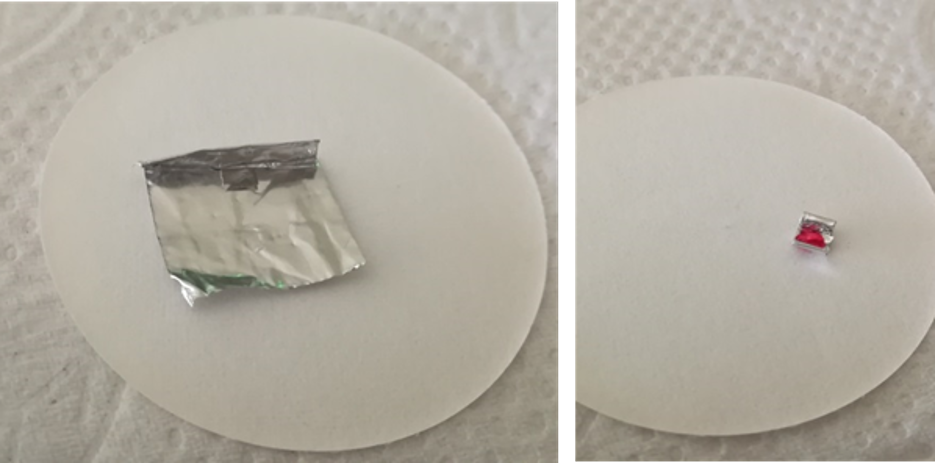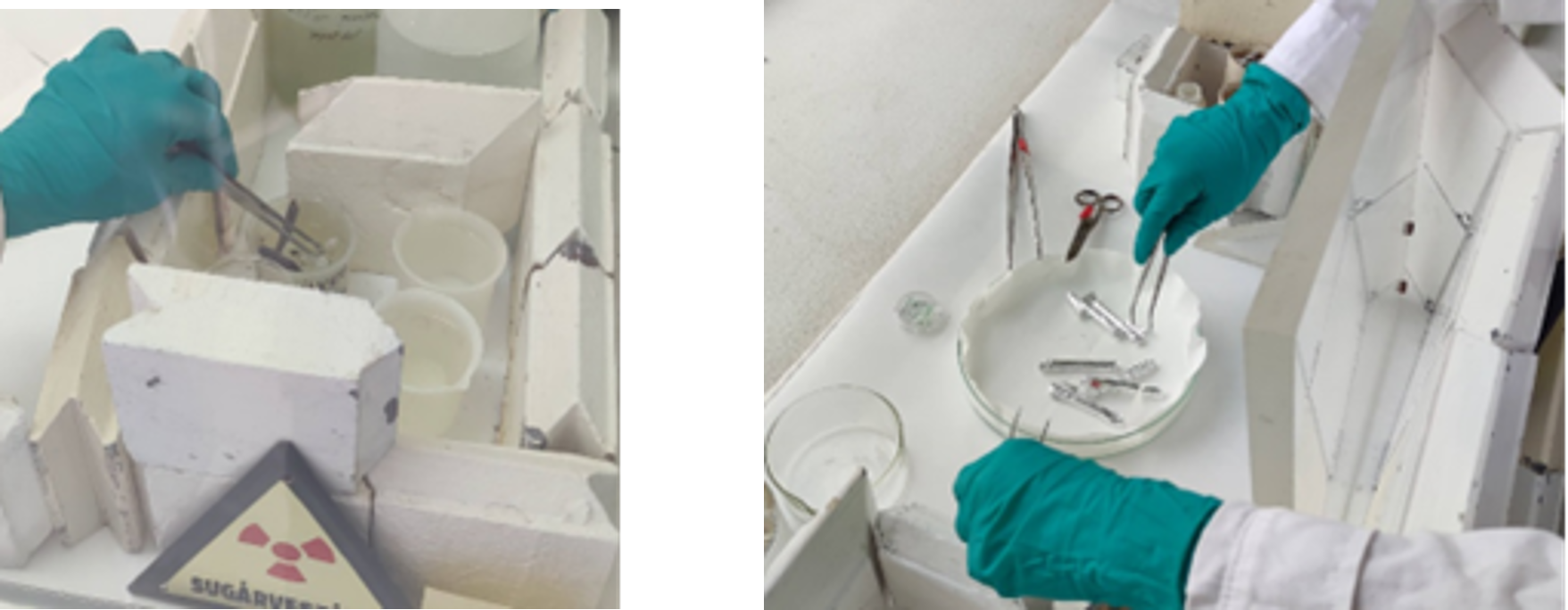- Name: NAA – Instrumental Neutron Activation Analysis
- Technique: Neutron Activation Analysis – NAA
- Range of investigated features: Mass fraction of mainly rare earth elements, about 35-50 elements in less than 0.01 μg quantities
- Penetration depth: Bulky analysis
- Typical size of sample: few tens of mg, 100-150 mg powder
- Measurable materials: geological, biological, archaeological organic and inorganic materials, silicates, minerals, metals, plants
- Contact: naa@bnc.hu
- Poster of the instrument

Neutron activation analysis (NAA) is a method for quantitative composition analysis of chemical elements based on the quantitative determination of gamma radiation emitted from radioactive nuclei formed as a result of neutron capture of stable nuclei.
The k0-standardized neutron activation analysis (k0-NAA), combined with high-resolution and high-throughput gamma-ray spectrometry, offers mostly non-destructive, multi-elemental analysis for many branches of science and technology. Small amounts (~10 tens of milligrams) of (mostly solid) samples can be measured, in which about 35-50 elements in less than 0.01 μg quantities can be determined.
Samples are irradiated with neutrons in the well thermalized rotating irradiation channel of the reactor, from 10 minutes up to hours or days long-time. The gamma rays emitted from the sample are counted in low-level counting chambers. There are three counting chambers at the NAA laboratory of BNC, equipped with three high-purity Ge detectors and two digital gamma spectrometers to detect and collect the gamma spectra. The spectra are fitted using Hyperlab 2022. Calculations include automatic peak search, energy calibration the nonlinearity option, net peak area computation, and efficiency correction. For quantitative evaluation, the KayZero for Windows 3.37 program is used, based on k0-standardization.
Instrumental neutron activation analysis (NAA) is a method for quantitative composition analysis of chemical elements based on the partial conversion of stable nuclei in the sample to radioactive nuclei via known nuclear reactions. The selective measurement of the gamma radiation gives quantitative and qualitative information about the produced radioactive atoms.
The k0-standardized neutron activation analysis (k0-NAA), combined with high-resolution and high-throughput gamma-ray spectrometry, offers mostly non-destructive, multi-elemental analysis for many branches of science and technology. NAA has inherently favourable characteristics, negligible matrix effect, excellent selectivity, and high sensitivity.
The NAA is especially capable of trace element in particular rare earth elements. The limit of detection is less than 0.01 μg for 35-50 elements, depending on the nuclear properties of the elements of interest, the measurement conditions, the neutron flux, density, and in some cases the matrix composition. Even small amounts (a few tens of milligrams) of (mostly solid) samples can be measured.
Samples are irradiated with neutrons in the well thermalized rotating vertical irradiation channel placed in the beryllium reflector layer of the reactor, arbitrary from 10 minutes up to hours or days duration.
The gamma rays emitted from the sample are counted in low-level gamma-spectroscopic counting chambers to reduce the external background. In the NAA laboratory of BNC there are three low-level gamma-spectroscopic chambers, which are built from pre-World War II steel (to be free from any man-made radioactivity), have 10 cm thick walls covered with a 2 mm thick Cu-layer from inside to attenuate the X-rays (Figure 1). Three high-purity Ge detectors and two digital gamma spectrometers are installed to detect and collect the gamma spectra (Table 1). D4 and D5 detectors are connected to a dual-input ORTEC DSPEC 502 digital gamma spectrometer (Table 2). The spectra with 2×16k channels recorded using the zero-dead time (ZDT) mode, to accurately account for the different time dynamics of the isotopes of interest. The corrected and uncorrected halves of the spectra are stored in a single SPC file.
Figure 1: Two high purity germanium detectors with dewars and the two low background chambers.
Table 1: Properties of the three high-purity germanium detectors.
| Detectors | Efficiency | Resolution @ 59.5 keV | Resolution @ 1332.5 keV | Dewar |
| ORTEC PopTop 55195-P “D5” | 55% | 0.95 keV | 1.75 keV | 30 l |
| Canberra GC3618 “D4” | 36% | 0.80 keV | 1.80 keV | 30 l |
| Canberra GC1318 “D3” | 13% | 0.95 keV | 1.80 keV | 30 l |
Table 2: Features of the spectrometers and spectrum displaying software
| Counting station | Spectrometers | Software (energy range) | Features |
| D3 | ORTEC DSPEC Plus | MAESTRO (30-2500 keV) | DSP-based, Zero-Deadtime Mode |
| D4 and D5 | ORTEC DSPEC 502 | MAESTRO (30-3300 keV) | DSP-based, Zero-Dead Time Mode |
NAA utilizes the delayed-gamma rays detected after the irradiation, in a separate step. Timing parameters are chosen based on calculations and earlier experiences, regarding the irradiation conditions at the channel. The optimization of irradiation, cooling, and measuring times should be done, regarding the number of radionuclides formed, which influences the selectivity of the measurement and the sensitivity of the analysis by increasing the background and spectral/irradiation interferences. The k0-standardization method does not require a standard for the analysis. Only a set of monitor foils essential for the quantification of the concentration calculations for the k0-method, thus Zr, Au, and Fe or Ni monitor foils are wrapped next to the samples during irradiation (Figure 3). Neutron flux parameters have been calculated with the “Bare Triple-Monitor” approach. The thermal neutron flux density of rotating irradiation channels (N°17) is around 3×1013 cm-2s-1, with f=50.
The spectra are evaluated using the gamma spectroscopy package Hyperlab 2022. Calculations include automatic peak search, energy calibration the nonlinearity option, net peak area computation, and efficiency correction. For quantitative evaluation, the KayZero for Windows 3.37 program is used, based on the k0-standardization, determining thermal and epithermal neutron flux ratio (f), alpha (α), and Fc calculation factors.
Most commonly measured samples are silicates, which should be powdered and homogenised. Samples for irradiation and measurement are filled, and after sealed in high-purity quartz vials (Figure 2 b; Suprasil AN, Heraeus). The quartz ampules are wrapped in an alumium foil, and 5-7 samples as a set can be encapsulated in an aluminum container (Figure 2 c). That irradiation capsule is placed in the rotating irradiation channel for a predetermined time. After irradiation and before the gamma counting, the quartz vials are surface-cleaned by chemical etching with a mixture of HF, acetic acid, and HNO3 solution, to remove any possible contaminations (Figure 4). To improve the detection limit for several medium- and long-lived radionuclides, after the first measurement following the irradiation, a few more measurements can be performed with different decay time. Thus, when the dominant short-lived isotopes decayed, then the long-lived radionuclides could be determined.

Figure 2: a) The No. 17 rotating, well-thermalized channel in the Be reflector of the BRR, used for long-term irradiation. b) High purity quartz ampule carrying the sample. c) Set of 6 quartz ampoules wrapped together using aluminum wire and also foils before being placed into the irradiation container.

Figure 3: Monitor-foils also wrapped in high-purity aluminum foil and wrapped next to the quartz ampules.

Figure 4: Before the gamma counting, the irradiated quartz vials are unwrapped from the Al-foil and surface-cleaned by chemical etching with a mixture of HF, acetic acid, and HNO3 solution.
Reference: László Szentmiklósi, Dénes Párkányi, Ibolya Sziklai-László, Upgrade of the Budapest neutron activation analysis laboratory, J. Radioanal. Nucl. Chem. (2016) 309 91–99